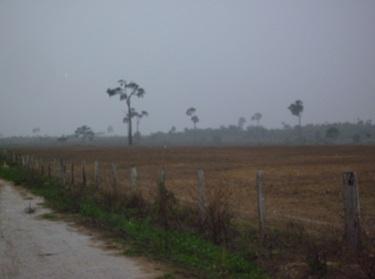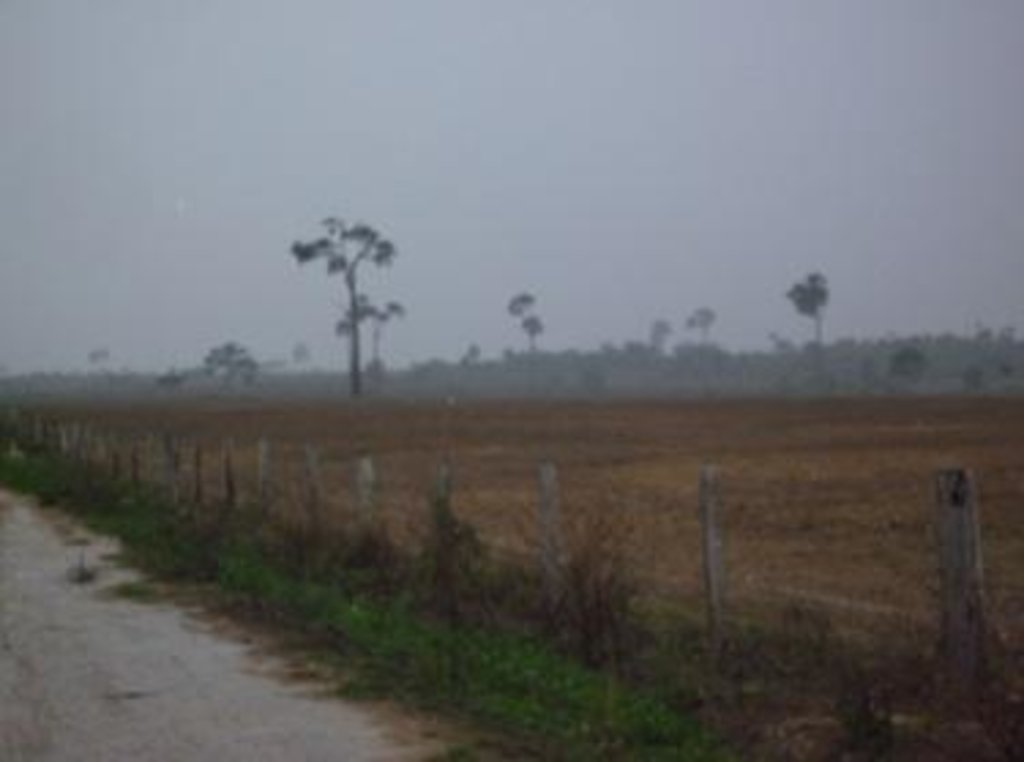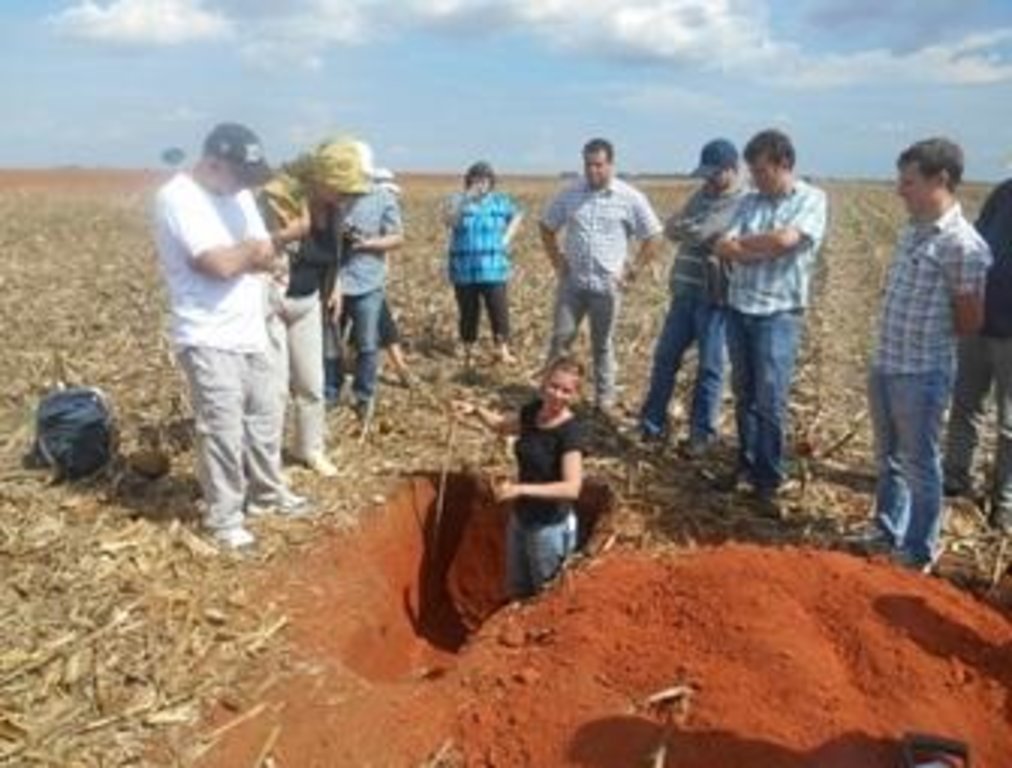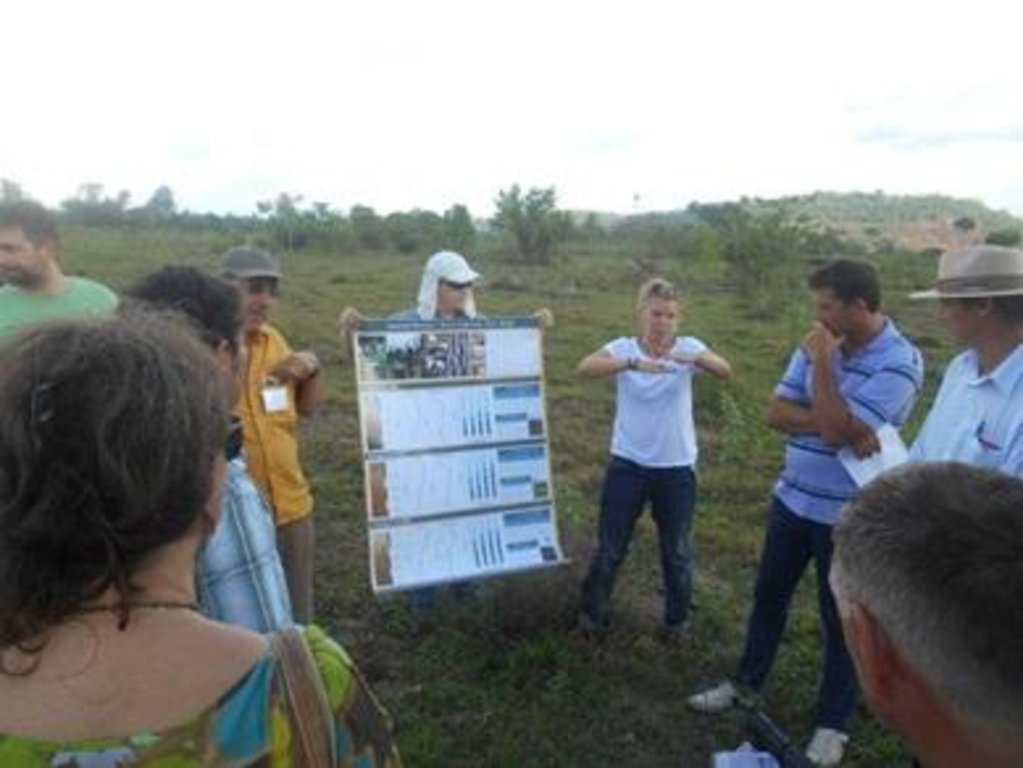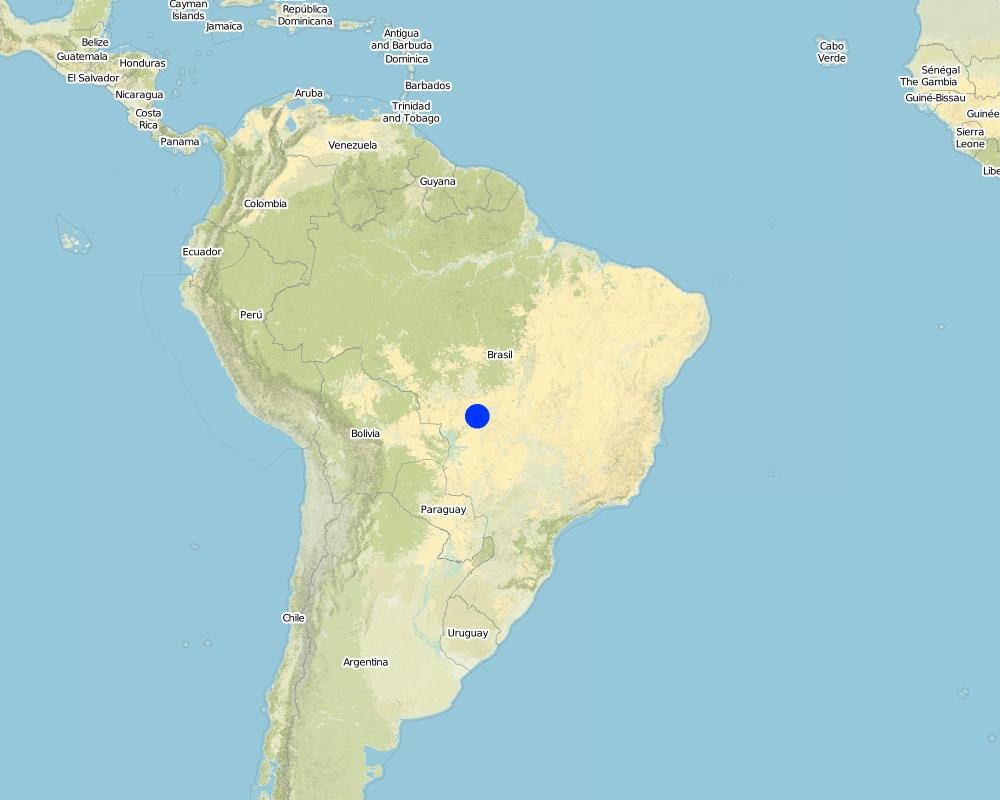Carbon stocks, turnover and nutrient budgets in soil along land-use and climatic gradients [巴西]
- 创建:
- 更新:
- 编制者: Stefan Hohnwald
- 编辑者: –
- 审查者: Fabian Ottiger
Estoque de Carbono
approaches_2529 - 巴西
查看章节
全部展开 全部收起1. 一般信息
1.2 参与方法评估和文件编制的资源人员和机构的联系方式
关键资源人员
SLM专业人员:
Strey Simone
Hoffmann@ifbk.uni-hannover.de
Institute of Soil Science, University of Hannover
Herrenhäuser Str. 2, 30419 Hannover
巴西
SLM专业人员:
Strey Robert
Institute of Soil Science, University of Hannover
巴西
SLM专业人员:
Boy Jens
Institute of Soil Science, University of Hannover
巴西
SLM专业人员:
Guggenberger Georg
Institute of Soil Science, University of Hannover
巴西
有助于对方法进行记录/评估的机构名称(如相关)
Institute of Soil Science, University of Hannover - 德国1.3 关于使用通过WOCAT记录的数据的条件
(现场)数据是什么时候汇编的?:
12/06/2015
编制者和关键资源人员接受有关使用通过WOCAT记录数据的条件。:
是
2. SLM方法的描述
2.1 该方法的简要说明
Find carbon optimized land management practices.
2.2 该方法的详细说明
该方法的详细说明:
Aims / objectives: (1) determine the native background stocks of N, P, K, Mg, Ca, and S in soil to a depth of 10 m in the native systems (rain forest and Cerrado).
(2) determine the temporal change in C and nutrient stocks using space-for-time substitution along the pioneer front gradient from central Mato Grosso to south Pará to assess the influence of land use on C and nutrient budgets.
(3) analyze the stocks of bulk C and of C in soil fractions differing in function and turnover to determine the influence of land use and soil management on distribution of SOM into different pools (i.e., analysis of the quantity and quality of C storage in soil).
(4) quantify the C turnover in these fractions by a combination of the stable C isotope and the 14C approaches (i.e., analysis of the sustainability vs. vulnerability of C storage in soil as affected by land use and soil management).
(5) assess the influence of climatic change on these parameters along the climatic gradient from central Mato Grosso to south Pará (i.e., analyze the sustainability vs. vulnerability of C storage in soil as affected by climate change).
(6) parameterize a C and N turnover model (e.g. CANDY, Rühlmann et al. 2006) at plot level and calculate different land-use and climate-change scenarios.
Methods: Analysing carbon stocks – sampling laboratory work (Elementar analyses).
Soil properties of the two most common soil types (texture, bulk density, pH, plant available nutrients, etc.).
Modelling– model the process of carbon storage after land-use change.
Stages of implementation: Transport into meanings – translate scientific results into recommendations for farmes which land-use type is most carbon friendly.
Role of stakeholders: Implementation of land use decision– depending on the soil properties.
2.3 该方法的照片
2.5 采用该方法的国家/地区/地点
国家:
巴西
区域/州/省:
Mato Grosso, Pará
有关地点的进一步说明:
Novo Progresso, Sinop, Cuiabá
Map
×2.6 该方法的开始和终止日期
注明开始年份:
2011
终止年份(若不再采用该方法):
2016
2.7 方法的类型
- 基于项目/方案
2.8 该方法的主要目的/目标
The Approach focused mainly on SLM with other activities (soil organic carbon pools)
Analyze the impact of different land use types on soil organic carbon storage after deforestation.
The SLM Approach addressed the following problems: the meaning of scientific results to farmers – there is no real importancy for them how much carbon is in their soil
The problem is that the whole climate change debate is based on Carbon, however by land use shift from rainforest to pasture or crop fields, soil organic carbon is not the parameter which is the most important, nevertheless is always in the focus if land-use change is discussed.
2.9 推动或妨碍实施本办法所适用的技术的条件
社会/文化/宗教规范和价值观
- 阻碍
They only do what they know – new ideas are hard to implement.
Treatment through the SLM Approach:
财务资源和服务的可用性/可得性
- 阻碍
Small farmers have no money to manage their land carbon friendly.
Treatment through the SLM Approach:
法律框架(土地使用权、土地和水使用权)
- 阻碍
Land titles are not clarified.
Treatment through the SLM Approach:
The existing land ownership, land use rights / water rights greatly hindered the approach implementation If farmers do not own the land by law they will not invest in protecting their land or invest in programs with duration over more than 5 years.
3. 相关利益相关者的参与和角色
3.1 该方法涉及的利益相关者及其职责
- 当地土地使用者/当地社区
Small Farmers with limited income; indigenous– Kayapó.
Women are not really active in the Brazilian agriculture.
- SLM专家/农业顾问
- 教师/学龄儿童/学生
- NGO
- 私营部门
- 国家政府(规划者、决策者)
- 国际组织
3.2 当地土地使用者/当地社区参与该方法的不同阶段
| 当地土地使用者/当地社区的参与 | 指定参与人员并描述活动 | |
|---|---|---|
| 启动/动机 | 被动 | The land users and communities were contacted by the research project. |
| 计划 | 互动 | Active in giving us allowance for our research. |
| 实施 | 外部支持 | Giving us a platform to present our results- communities. |
| 监测/评估 | 无 | Until now not happening. |
| Research | 被动 |
3.4 有关SLM技术选择的决策
具体说明谁有权决定选择要实施的技术:
- 仅限SLM专家
解释:
Decisions on the method of implementing the SLM Technology were made by by SLM specialists alone (top-down)
4. 技术支持、能力建设和知识管理
4.2 咨询服务
土地使用者有权使用咨询服务吗?:
是
指明是否提供了咨询服务:
- 在固定中心
说明/注释:
Name of method used for advisory service: Conferences; Key elements: presenting results, transport into meanings, podium discussion
Advisory service is quite adequate to ensure the continuation of land conservation activities; Results are a basis for further discussions of ‘good practice’ management on community level.
4.3 机构强化(组织发展)
是否通过这种方法建立或加强了机构?:
- 是,少许
具体说明机构的强化或建立程度:
- 本地
具体说明支持类型:
- 能力建设/培训
提供进一步细节:
Workshop 'What is carbon?' to indigenous people (Indian tribe Kayapó)
4.4 监测和评估
注释:
There were no changes in the Approach as a result of monitoring and evaluation
There were no changes in the Technology as a result of monitoring and evaluation
4.5 研究
研究是该方法的一部分吗?
是
明确话题:
- 生态学
提供进一步的细节,并指出是谁做的研究:
Research was carried out both on station and on-farm
5. 融资和外部物质支持
5.1 该方法中SLM组成部分的年度预算
如果不知道准确的年度预算,请给出一个范围:
- 10,000-100,000
注释(例如主要的资助来源/主要捐助者):
Approach costs were met by the following donors: government (German Government, BMBF): 100.0%
5.2 为土地使用者提供财政/物质支援
土地使用者是否获得实施该技术的财政/物质支持?:
是
5.3 对特定投入的补贴(包括劳动力)
- 设备
| 具体说明哪些投入得到了补贴 | 程度如何 | 对补贴做出具体说明 |
|---|---|---|
| 机械 | 部分融资 | |
| 工具 | 部分融资 | |
注释:
equipment: machinery not financed.
equipment: tools fully financed.
5.4 信用
是否根据SLM活动的方法给予信用值?:
否
6. 影响分析和结论性陈述
6.1 方法的影响
该方法是否帮助土地使用者实施和维护SLM技术?:
- 否
- 是,很少
- 是,中等
- 是,支持力度很大
They have results about their soil properties which may help their agriculture advisers.
该方法是否有助于社会和经济弱势群体?:
- 否
- 是,很少
- 是,中等
- 是,支持力度很大
该方法是否改善了阻碍SLM技术实施的土地使用权/用户权问题?:
- 否
- 是,很少
- 是,中等
- 是,支持力度很大
The problem is likely to be overcome in the near future. If the government pushes the land title process forward.
Did other land users / projects adopt the Approach?
- 否
- 是,很少
- 是,中等
- 是,支持力度很大
Did the Approach lead to improved livelihoods / human well-being?
- 否
- 是,很少
- 是,中等
- 是,支持力度很大
Until now not clear because it is a long term process.
Did the Approach help to alleviate poverty?
- 否
- 是,很少
- 是,中等
- 是,支持力度很大
This is not the aim of the approach.
6.2 土地使用者实施SLM的主要动机
- 增加生产
- 增加利润(能力),提高成本效益比
- 减少工作量
- 支付/补贴
- 规章制度(罚款)/执行
- 声望、社会压力/社会凝聚
- 加入运动/项目/团体/网络
- 环境意识
- 美学改进
- well-being and livelihoods improvement
6.3 方法活动的可持续性
土地使用者能否维持通过该方法实施的措施(无外部支持的情况下)?:
- 不确定
若否或不确定,请具体说明并予以注释:
The political program concerning land use change needs to be changed or must support the farmers.
6.4 该方法的长处/优点
| 编制者或其他关键资源人员认为的长处/优势/机会 |
|---|
|
The possibility to work with indigenous people on the same topic (soil organic carbon) as with farmers. |
6.5 该方法的弱点/缺点以及克服它们的方法
| 编制者或其他关键资源人员认为的弱点/缺点/风险 | 如何克服它们? |
|---|---|
|
Too much scientific research from top-down on a topic which farmers are not really interested in. |
Plan the project with locals. |
7. 参考和链接
7.1 方法/信息来源
- 实地考察、实地调查
- 与土地使用者的访谈
链接和模块
全部展开 全部收起链接
无链接
模块
无模块


